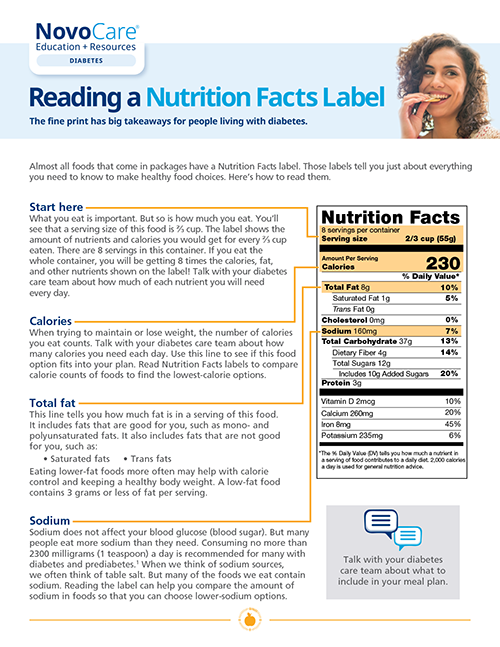
EATING
Get the feel-good facts on food labels

The fine print has big takeaways for people living with diabetes.
Nutrition labels have got a lot going on. There are percentages, numbers, and all different kinds of fats and sugars. Bottom line: Labels can be confusing. But, when you focus on these 6 things, it may help you decide whether a food fits into your diabetes nutrition plan.

- Check the serving size
You’ll notice most packages contain more than 1 serving. In fact, this label shows the package contains 8 servings!
- Keep an eye out for certain fats
Look at the amount of saturated and trans fats in each serving.
- Count on total carbohydrates (carbs)
Don’t worry about counting the total sugar and fiber grams. They are included in the total carbohydrateCarbohydrateCarbohydrates are the main kinds of food that raise blood glucose levels. Your digestive system changes carbohydrates into glucose, and then uses this glucose as a source of energy for your cells.
There are 3 main types of carbohydrates in food: starches (complex carbohydrates), sugars (simple carbohydrates), and fiber. Fiber is the part of plant foods, including fruits, vegetables, and nuts, that you can’t digest. number.
- Get your fiber on
Fiber is the part of plant foods that the body does not digest. It can help lower blood cholesterol, slow sugar absorption, and keep bowel movements regular. Adults should aim to eat 25 to 35 grams of fiber a day.
- Added sugar is less appealing
Sugars raise blood glucoseBlood glucoseThe main sugar found in the blood, and the body’s main source of energy. quickly. So, it’s important to avoid foods with added sugar.
- Pack on the protein
Most people don't get enough protein. Protein is needed by the body. It'll help you feel full AND has very little effect on blood glucose. Of course, proteins still have calories, so try to keep portion sizes between 3 and 6 ounces per meal.
By understanding the labels and making healthy food choices, you can help keep your blood glucose levels in a good range. Be sure to chat with your doctor or someone on your diabetes care teamDiabetes care teamYour diabetes care team may include a primary care doctor, a diabetes and hormone doctor (endocrinologist), a registered nurse, a diabetes educator, a dietitian, a heart doctor (cardiologist), a foot doctor (podiatrist), an eye doctor (ophthalmologist/optometrist), a kidney doctor (nephrologist), a dentist, a pharmacist, and a mental health professional. if you’re looking to change up your meal plan. Together, you can better manage your nutrition!
Test your knowledge
The % daily value on food labels is typically based on a diet that includes how many calories a day?
Correct!
Sorry, that's incorrect.
The % daily value on food labels is typically based on a 2000 calorie-a-day diet. Your doctor may recommend more or less, depending on your age, health status, and activity level.



